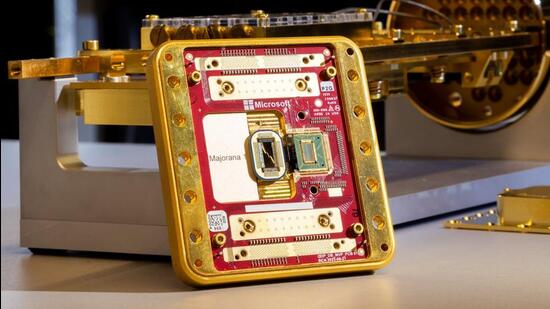Microsoft Majorana 1’s state of matter approach to quantum computing
Microsoft’s leap in quantum computing chips closely follows Google’s Willow chip, IBM’s Quantum Heron now leveraging the Qiskit quantum software, as well as the Zuchongzhi 3.0.
Microsoft has developed a new quantum computing chip, Majorana 1, that can potentially fit a million qubits. Though this chip currently holds 8 topological qubits, it is a first of its kind to have a significant scalability runway. Key to its versatile architecture is the creation of a new material, made from indium arsenide and aluminium.

Microsoft’s leap in quantum computing chips closely follows Google’s Willow chip, IBM’s Quantum Heron now leveraging the Qiskit quantum software, as well as the Zuchongzhi 3.0, developed by Chinese scientists late last year
“After a nearly 20-year pursuit, we’ve created an entirely new state of matter, unlocked by a new class of materials, topoconductors, that enable a fundamental leap in computing,” says Satya Nadella, chairman and CEO at Microsoft. “The qubits created with topoconductors are faster, more reliable, and smaller. They are 1/100th of a millimeter, meaning we now have a clear path to a million-qubit processor,” he explains.
A key element of Microsoft’s quantum chip is the Topological Core, which they believe makes it more stable with error resistance incorporated at the hardware level.
“Whatever you’re doing in the quantum space needs to have a path to a million qubits. If it doesn’t, you’re going to hit a wall before you get to the scale at which you can solve the really important problems that motivate us,” says Chetan Nayak, Microsoft technical fellow, explaining the approach to developing Majorana 1.
Quantum computing references computation that harnesses principles of quantum mechanics — specifically superposition, entanglement, and quantum interference — to perform operations on data.
This contrasts with classical computers, which use bits representing either 0 or 1.
“Modern computer processors are quite efficient at performing the discrete computations they’re usually tasked with. Though their efficiency nosedives when they must wait for data to move back and forth between memory and compute, they’re designed to quickly switch over to work on some unrelated task,” explains Geoffrey Burr, an IBM Research scientist.
Quantum computers use qubits, which can represent 0, 1, or a combination of both simultaneously. Microsoft Azure describes differences between qubit and bits, “A qubit can represent a 0, a 1, or any proportion of 0 and 1 in superposition of both states, with a certain probability of being a 0 and a certain probability of being a 1.”
“A huge milestone they have been pursuing for quite some time. Now comes the scaling for truly fault tolerant quantum computing. It will take a while, but this is a foundational technology for humanity,” says Gill Verdon, Founder and CEO of Extropic ai, a company that’s building computing solutions that merge with generative AI.
Quantum computing’s big promise is an ability to do computations that would otherwise take today’s traditional computers hundreds or thousands of years to complete. There is the promise and potential of solving real-world problems. But alongside come the negatives too, such as threats to modern-day cybersecurity systems with possible threats that would break current encryption and firewall methods.
Microsoft believes a million qubits should be the minimum threshold for quantum computers to be able to deliver solutions for real-world problems. They cite examples such as breaking down microplastics into harmless byproducts, developing self-healing materials for construction, or applications in manufacturing or healthcare.
The new materials stack made of indium arsenide and aluminium, has largely been designed and fabricated by Microsoft engineers.
A new approach
There are different ways in which quantum computing chips encode and manipulate quantum information. Topological qubit is the technology used by Majorana 1, which essentially follows the method of braiding electrons (in this case, the variation in play is anyons) to make information that’s stored more stable and less susceptible to volatility such as temperature fluctuations.
Google Willow and IBM’s Heron chips are classified as Superconducting qubit chips while IonQ’s chips use the Trapped Ion qubit technology. The choice is made based on various factors, including ease of implementation, handling of complex data and resistance to errors depending on type of computation.
At this time, commercial implementation of Majorana 1 is not on the table, a contrast to Microsoft’s Maia 100 artificial intelligence chip that’s available to enterprise clients via their Azure platform.
The idea for Majorana 1 is further research, for its own development, and use-cases for which they’ll work closely with academia and laboratories. Microsoft is making the quantum computing chip itself, and not relying on any chip making partners such as Taiwan Semiconductor.
Any commercial deployments, will come in due course.
As AI philosopher David Shapiro wrote on in a post on X, “the technological advancement hinges on Microsoft’s ability to construct their quantum chip atom by atom using indium arsenide and aluminium, creating a new state of matter that’s neither solid, liquid, nor gas.”
Google believes commercial quantum computing applications are just a few years away, and in their estimates, that timeline extends to about 5 years. IBM says 2033 will be the year quantum computing will achieve commercial status.
Research by McKinsey & Company estimates quantum computing tech will likely create value worth trillions of dollars within the next decade. In their latest, annual Quantum Technology Monitor, they note that four sectors—chemicals, life sciences, finance, and mobility—are likely to see the earliest impact from quantum computing, and could gain up to $2 trillion by 2035.
For Microsoft, the theory suggests Majorana 1 is writing a new chapter for quantum computing. Quite how well this turns out in the real-world will become clear in the months to come, and for that, Microsoft is well positioned to experiment.






